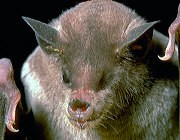
Photo from wikipedia
In contrast to birds, the relationship between migration and immunity has been scarcely studied in bats. We examined how the expression of the humoral portion of the constitutive immunity varied… Click to show full abstract
In contrast to birds, the relationship between migration and immunity has been scarcely studied in bats. We examined how the expression of the humoral portion of the constitutive immunity varied in a bat with partial, sex-biased migration: the lesser long-nosed bat (Leptonycteris yerbabuenae (Phyllostomidae)). The lesser long-nosed bat is a nectarivorous species distributed in the arid and semi-arid regions of North and Central America. We evaluated the bacteria-killing abilities (BKAs) of the plasma of male and female lesser long-nosed bats on the Pacific coast in different periods of the year. Because adult males are resident, they were used to explore the effect of reproductive activity on BKA, and we predicted higher values in mating males (i.e., individuals presenting scrotal testicles and a fresh dorsal patch). In contrast to males, most females migrate to cactus deserts in northern Mexico during pregnancy and lactation, and then return to the dry forests of west-central Mexico to mate. We predicted that the combined effect of breeding and migration would have an adverse effect on BKA; therefore, migratory pregnant and lactating females were expected to exhibit a lower BKA than mating females in west-central Mexico. We compared the BKAs of females captured in October and December in central Mexico, and we predicted that migratory females that had recently arrived in October should exhibit a lower BKA than females captured two months later. In addition, we compared the BKAs between lactating females and young in northern Mexico and predicted lower values in recently born individuals. We found that the BKAs of males were higher in reproductive individuals than in non-reproductive individuals. We found a significant difference in the BKAs between females at the two extremes of their migratory range: the values of pregnant females in Sonora and females in December were higher than those of females captured in October. Finally, we found no difference in BKAs between lactating females and young individuals. Our findings indicate that the basal levels of the innate humoral component are heightened in mating males, that this response is reduced in females that recently returned to their mating grounds, and that the constitutive immunity of young individuals matures early, probably in anticipation of the potential to encounter pathogens during their migration to west-central Mexico.
Journal Title: Diversity
Year Published: 2023
Link to full text (if available)
Share on Social Media: Sign Up to like & get
recommendations!